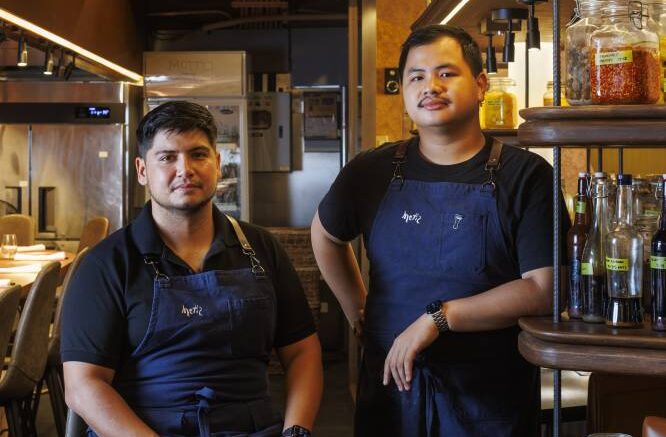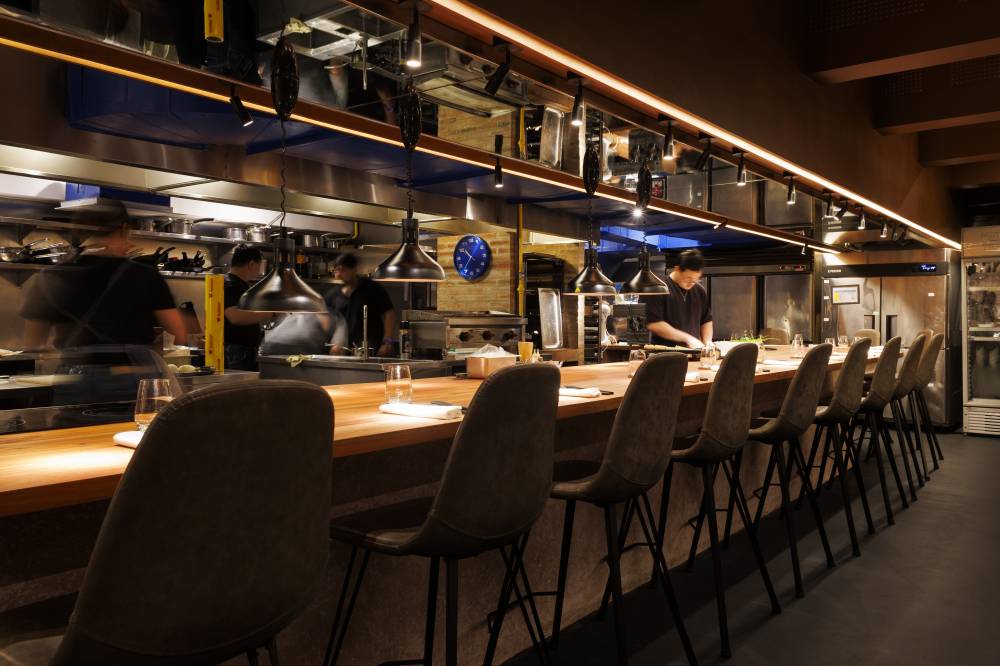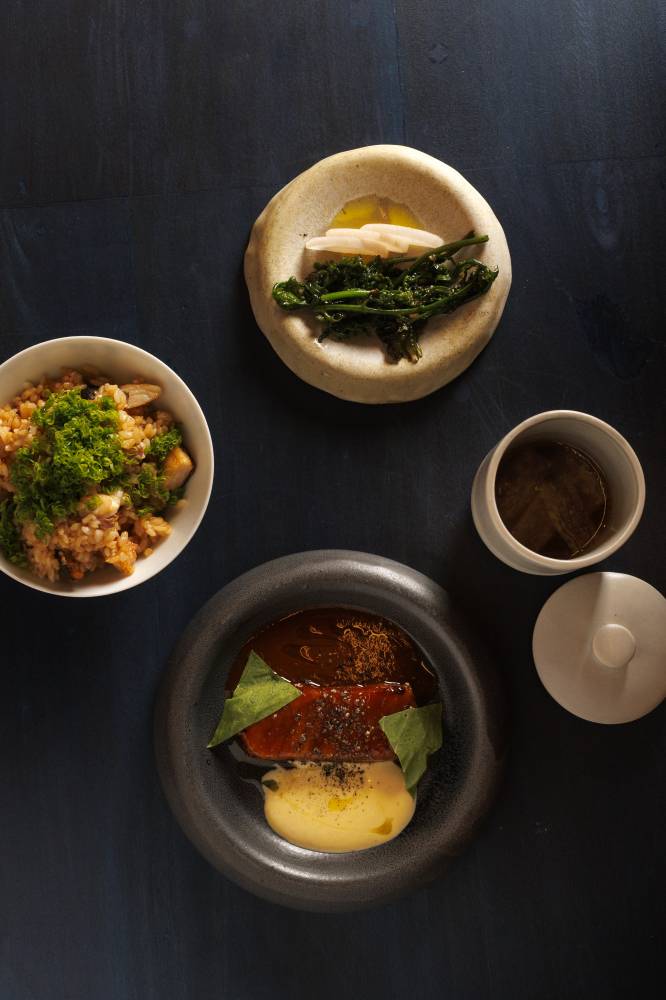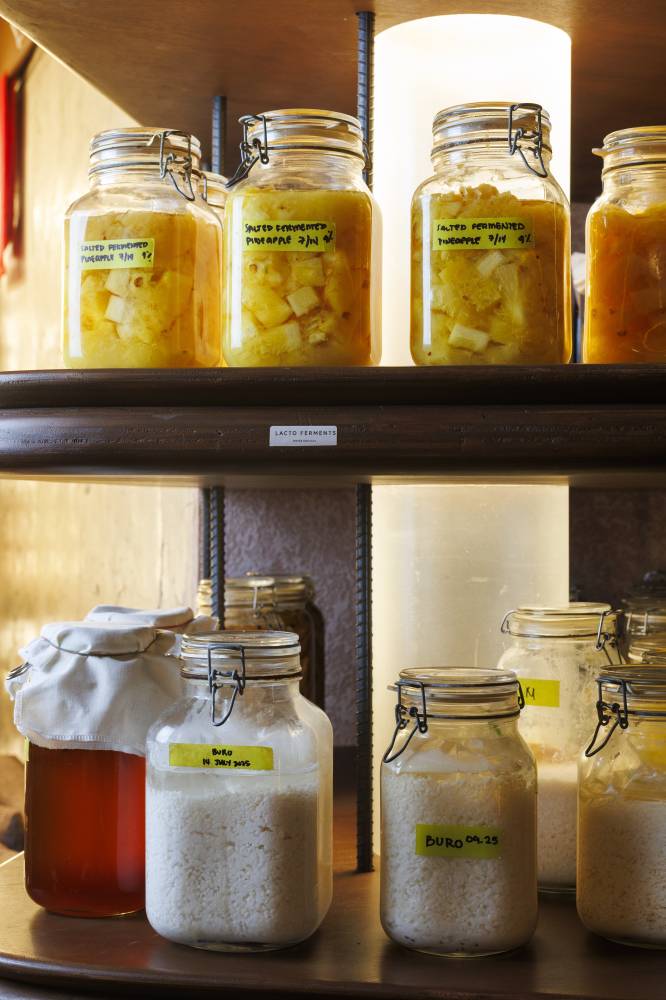The new Metiz is a sequel that stands on its own

At the old Metiz, there was a large bookshelf that stood in the middle of the space. It was a beautiful wooden piece, but its chefs admit it obscured the view of the dining area from the rest of the kitchen. Now, at first glance, the newly opened Metiz is almost unrecognizable.
Walking in, your eyes sweep over the chefs in motion, silently in focus at their own stations in the kitchen, then to the long stretch of a wooden counter with lights hanging low, and finally, the lounge seats to your right, framed by shelves of bottled and jarred ferments that clue you in on the meal to come.
Executive chef Stephan Duhesme, along with assistant executive head chef and owner Arlo Gregorio, bring the restaurant’s focus to the food and the kitchen with this reopening. “We wanted to make every table feel like a chef’s table. If you’re to notice every single area, even the private room, there’s an eye toward the kitchen. It really feels like there’s an immersive experience.” Gregorio says.
Ideas for these renovations began building up around 2023 when their fermentation-forward Filipino menu gained recognition from local magazines and debuted at 48th in Asia’s 50 Best Restaurants. During those years, the chefs were able to truly stretch out the restaurant’s legs and figure out what it could be, but in realizing what they could do, they were able to feel out the structural elements that were holding them back.
“Metiz essentially is a brand new restaurant,” Duhesme says, likening this 2.0 version to a sequel. “We are not resting on our previous laurels or anything like that; we really are starting from scratch.” And so we treat it as such. The marker of a good sequel, after all, is not how faithful it is to the original; what makes it compelling is how well it can stand on its own.

A versatile menu
The dynamic between the two chefs is significant in the restaurant’s new iteration. In conversations with their team, they envisioned what the optimal kitchen space would look like to set the pace for how their menu develops. “What’s good is that we have the same perspectives, but also different enough to sort of have that creative friction,” Gregorio says.
“We know what we want. We really wanted to build a space for our regulars,” Duhesme adds. They’re not yes men to each other, but not contrarians either; they challenge each other with a “Yes, and?” approach to their ideas.
Their reimagined menu, which is still in development, is shorter and built on the idea of grouping dishes together. They call them “movements” instead of set courses. According to the chefs, it allows the kitchen to adapt according to seasonality and to continue playing with the boundaries of what Filipino food can become in their own space.
“[With the menu], what we’re moving toward is an abstraction of the idea of what Filipino food is,” Duhesme says. He draws some similarities to how art movements evolve—moving from realism or hyperrealism to abstract tendencies.
Which is to say, perhaps after the cultural zeitgeist of traditional Filipino cooking in recent years, both chefs and diners are excited about the prospect of exploration and departure from the classics, done through focusing on evoking the emotions you feel after a first bite of your grandmother’s cooking rather than strictly following a particular dish’s recipe. “A lot of the chefs cooking [in Manila] are actually third culture kids,” Gregorio points out. “It’s all the kids of the diaspora growing up and opening restaurants, longing, nostalgic for the flavors that their parents used to cook.”

Served in movements
The first movement of their menu began with two dishes that contrasted each other in presentation. The first is a colorful ensalada of various vegetables, coconut cream, bagoong, kasoy praline, and dikai leaf. The second is a more minimalist plate of roasted squash, sardine, and kasoy nilupak. Together, the first movement already hits so many notes—from the salty sardine, to the sweet bite of squash, then the savory bagoong, and the refreshing tang of manibalang mangoes.
The ensaymada, served in the second movement, is a regular from their past menus, whose original recipe comes from head chef Kevin Soliven’s grandmother, translated from Spanish, then iterated into the twice-baked brown butter-glazed pastry that it is today. A generous sprinkling of Gouda cheese from Davao, and on the side, a silky egg with confit potatoes and a briney foam sauce rounds out the sweetness with a salty and creamy texture.
The chicken broth from the third movement teases memories of the native Filipino chicken soups one would serve to welcome guests or family paying a visit in the province. The flavor of the native chicken stands out for its meaty and intense flavor compared to broths you’d make with other chickens.
The meal ends with a seasonal dessert of frozen rambutan sliced into cubes. From August to October, the rambutan is so delicately sweet and floral—a joy to eat mixed with a puree of fermented santol and rambutan, a puff of cream with fermented rice, and a drizzle of ampalaya oil that lends contrast with its grassy notes.
Their menu is still in development, meaning that what they serve today might still be improved upon or changed entirely in six months. Operationally, they are still tweaking, finalizing food costs, making it sustainable for both shareholders and their customers—but the mainframe is there. Just as the old Metiz took time to get its legs, Duhesme also believes the idealized version of the restaurant is yet to be realized.

Still warming up
This Metiz 2.0 is a refinement of the chefs’ vision for the restaurant. As all good sequels should—you won’t need to have been to the last one to appreciate what this one has to offer.
The pair clarifies that they’re not in this simply to fill their shelves up with awards and plaques; they’d rather look out the kitchen and see diners filling up their seats, enjoying their food.
“When the goal is about bettering the customer satisfaction, trying to find interesting alleyways into making our food, and asking the right questions for what Filipino food and cuisine [could be], you realize that your work becomes lifelong,” Duhesme says. “There’s also satisfaction in knowing that this is the current stage of our work. We’ll see what it’s like in five years, in 10 years. We’re constantly evolving as people, and this space really is just a medium for the ideas and the team.”
Gregorio adds, “The spaces can move, the spaces can change, but the core belief has to be there.”

















